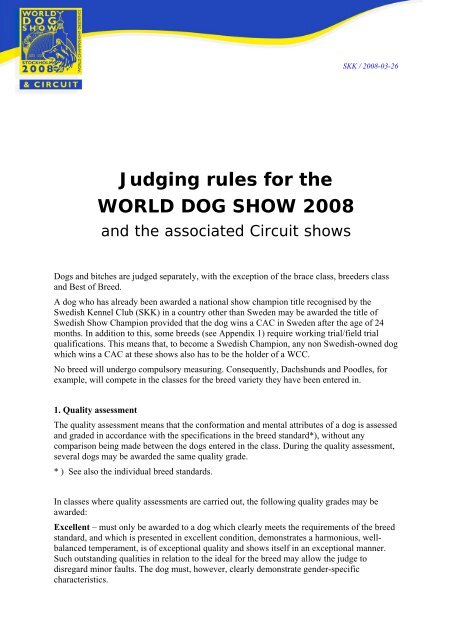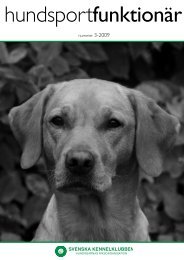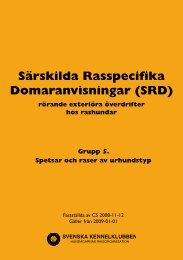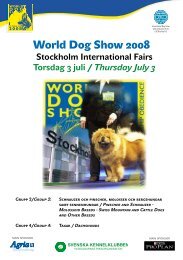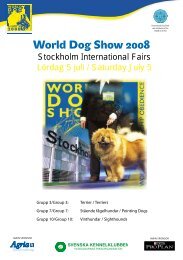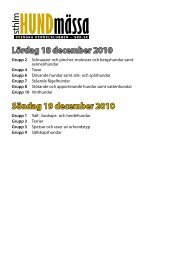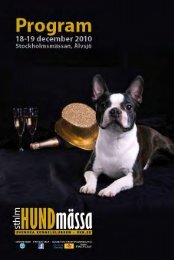World Dog Show - Regler för bedömning
World Dog Show - Regler för bedömning
World Dog Show - Regler för bedömning
You also want an ePaper? Increase the reach of your titles
YUMPU automatically turns print PDFs into web optimized ePapers that Google loves.
SKK / 2008-03-26<br />
Judging rules for the<br />
WORLD DOG SHOW 2008<br />
and the associated Circuit shows<br />
<strong>Dog</strong>s and bitches are judged separately, with the exception of the brace class, breeders class<br />
and Best of Breed.<br />
A dog who has already been awarded a national show champion title recognised by the<br />
Swedish Kennel Club (SKK) in a country other than Sweden may be awarded the title of<br />
Swedish <strong>Show</strong> Champion provided that the dog wins a CAC in Sweden after the age of 24<br />
months. In addition to this, some breeds (see Appendix 1) require working trial/field trial<br />
qualifications. This means that, to become a Swedish Champion, any non Swedish-owned dog<br />
which wins a CAC at these shows also has to be the holder of a WCC.<br />
No breed will undergo compulsory measuring. Consequently, Dachshunds and Poodles, for<br />
example, will compete in the classes for the breed variety they have been entered in.<br />
1. Quality assessment<br />
The quality assessment means that the conformation and mental attributes of a dog is assessed<br />
and graded in accordance with the specifications in the breed standard*), without any<br />
comparison being made between the dogs entered in the class. During the quality assessment,<br />
several dogs may be awarded the same quality grade.<br />
* ) See also the individual breed standards.<br />
In classes where quality assessments are carried out, the following quality grades may be<br />
awarded:<br />
Excellent – must only be awarded to a dog which clearly meets the requirements of the breed<br />
standard, and which is presented in excellent condition, demonstrates a harmonious, wellbalanced<br />
temperament, is of exceptional quality and shows itself in an exceptional manner.<br />
Such outstanding qualities in relation to the ideal for the breed may allow the judge to<br />
disregard minor faults. The dog must, however, clearly demonstrate gender-specific<br />
characteristics.
Judging Rules for the <strong>World</strong> <strong>Dog</strong> <strong>Show</strong> 2008<br />
and the associated Circuit shows<br />
SKK / 2008-03-26<br />
Very good – may only be awarded to a dog which clearly meets the requirements of the breed<br />
standard, is well-balanced and in good condition. Minor faults may be tolerated, provided that<br />
they do not have a negative impact on the overall impression. This grade can only be awarded<br />
to a dog of very good standard.<br />
Good - to be awarded to dogs which meet the requirements of the breed standard but which<br />
display less significant conformation-related faults.<br />
Sufficient - to be awarded to dogs which meet the requirements of the breed standard, but<br />
which do not possess all the characteristics typical of the breed or which are in poor physical<br />
condition.<br />
Disqualified - to be awarded to dogs which do not meet the requirements of the breed<br />
standard, which demonstrate aggressive behaviour or a behaviour untypical for the breed,<br />
which do not have two normally-descended testicles, which have a faulty bite *) or deformed<br />
jaw(s), which are not of the correct colour or coat type or which show clear signs of albinism.<br />
This grading should also be awarded to dogs which suffer from defects which may have a<br />
negative impact on their health, and to dogs which display faults which are listed as<br />
disqualifying faults in the breed standard.<br />
*) Where a faulty bite is specified as a disqualifying fault in the breed standard.<br />
A ”Disqualified” grade should always be entered on the judge's report and in the list of<br />
results.<br />
In addition, judges must verify by signing the list of results any Disqualified grade which has<br />
been awarded to a dog which has demonstrated aggressive behaviour or a clear tendency to<br />
flight in the ring, i.e. a dog which has panicked and shied away from the judge, and where<br />
there has been no possibility of approaching the dog in a natural manner. Other forms of<br />
behaviour are to be judged in accordance with the requirements of the breed standard.<br />
Cannot be judged - This grade must be awarded to dogs which refuse to move, constantly<br />
jump up or which try to leave the ring, if such behaviour makes it impossible to judge the<br />
dogs' stride and movement. This grade must also be awarded to dogs which back away from<br />
the judge in such a way that it is impossible to asses the dogs' bite and teeth, anatomy and<br />
conformation, tail or testicles, or which show traces/signs of prohibited surgery or treatment<br />
(e.g. on eye lids, ears or tail). The reason for awarding a "Cannot be judged" grade must<br />
always be stated in the judge’s written critique.<br />
2. Competition class<br />
In a competition class, dogs awarded a minimum grade of Very Good in a class are judged<br />
against the other dogs awarded the same minimum grade in the same class. The dogs are<br />
placed 1st to 4th.<br />
NB! If four or more dogs in a class are graded Excellent, dogs graded Very Good will not be<br />
invited back into the ring to be placed.<br />
2
Judging Rules for the <strong>World</strong> <strong>Dog</strong> <strong>Show</strong> 2008<br />
and the associated Circuit shows<br />
SKK / 2008-03-26<br />
3. <strong>Dog</strong>s arriving too late<br />
a) <strong>Dog</strong>s which arrive at the ring after quality assessment in their class has been completed,<br />
but before judging of the associated competition class has commenced, may undergo a<br />
quality assessment and may then, if awarded a qualifying grade, progress to the associated<br />
competition class.<br />
b) <strong>Dog</strong>s which arrive at the ring for assessment after judging of the competition class in<br />
which they would have appeared has been completed do not have the right to participate<br />
in the competition class. If time permits, such dogs may be issued with a written judge's<br />
report and awarded a quality grade when judging of the breed or the ring has ended. Since<br />
such a dog has not been placed in its class, it cannot progress further in the show.<br />
4. Obligation to participate in the class entered<br />
Exhibitors who have appeared in the ring for the purpose of having a dog assessed in the class<br />
in which it has been entered are obliged to participate in that class and in the subsequent<br />
competition class, if any.<br />
Classes and order of judging<br />
A dog may only be entered in one (1) class at a show (with the exception of brace and<br />
breeders classes).<br />
For classes which are subject to an age limit, the dog's age is the age which it has reached on<br />
the day that it is being exhibited.<br />
5. Junior class - 9-18 months<br />
This class is open to dogs which, on the day they are being exhibited, are over 9 months and<br />
under 18 months old. (NB! <strong>Dog</strong>s entered in this class can not compete for CACIB).<br />
In this class, the quality of the entered dogs is assessed. <strong>Dog</strong>s which are awarded a minimum<br />
quality grade of Very Good progress to the junior competition class.<br />
6. Junior competition class<br />
This class is open to dogs which, at the show in question, are awarded a minimum grade of<br />
Very Good in the junior class. NB! If four or more dogs in the class are graded Excellent, dogs<br />
graded Very Good will not be invited back into the ring to be placed.<br />
In this class, the dogs are judged against each other. If the winning dog has been awarded an<br />
Excellent grade, it will also be awarded the title of <strong>World</strong> Junior Winner 2008, and is entitled<br />
to compete for the CAC, Best of Breed and Best Junior in Breed.<br />
3
Judging Rules for the <strong>World</strong> <strong>Dog</strong> <strong>Show</strong> 2008<br />
and the associated Circuit shows<br />
SKK / 2008-03-26<br />
7. Intermediate class - 15-24 months<br />
This class is open to dogs which, on the day they are being exhibited, are over 15 months and<br />
under 24 months old.<br />
In this class, the quality of the entered dogs is assessed. <strong>Dog</strong>s which are awarded a minimum<br />
quality grade of Very Good progress to the intermediate competition class.<br />
8. Intermediate competition class<br />
This class is open to dogs which, at the show in question, have been awarded a minimum<br />
grade of Very Good in the intermediate class. NB! If four or more dogs in a class are graded<br />
Excellent, dogs graded Very Good will not be invited back into the ring to be placed.<br />
In this class, the dogs are judged against each other. If the winning dog has been awarded an<br />
Excellent grade, it is entitled to compete for the CAC and CACIB.<br />
9. Working trial/Field trial class - 15 months and over<br />
These classes are organised for breeds in accordance with the relevant FCI list. The classes<br />
are open to dogs with qualifications from working or field trials which, on the day that they<br />
are being exhibited, are 15 months old or over.<br />
For non Swedish-owned dogs, the show entry must be accompanied by a WCC certificate.<br />
Swedish-owned dogs require qualifications from working or field trials as stated in the special<br />
provisions for individual breeds in the Swedish Kennel Club's breed show regulations. <strong>Dog</strong>s<br />
which have obtained a WCC or trial qualifications after the last entry date do not have right<br />
to change class.<br />
In this class, the quality of the entered dogs is assessed. <strong>Dog</strong>s which are awarded a minimum<br />
quality grade of Very Good progress to the working trial/field trial competition class.<br />
10. Working trial/field trial competition class<br />
This class is open to dogs which, at the show in question, have been awarded a minimum<br />
grade of Very Good in the working trial/field trial class.<br />
NB! If four or more dogs in a class are graded Excellent, dogs graded Very Good will not be<br />
invited back into the ring to be placed.<br />
In this class, the dogs are judged against each other. If the winning dog has been awarded an<br />
Excellent grade, it is entitled to compete for the CACIB. The highest-placed dog which has<br />
been awarded an Excellent grade and is entitled to compete for CACs will go on to compete<br />
for the CAC.<br />
CAC (Challenge Certificate)<br />
For breeds where CACs are also awarded in working trials/field trial classes (see Appendix<br />
2), one (1) CAC and one (1) Reserve-CAC can be awarded in this class. These will be<br />
4
Judging Rules for the <strong>World</strong> <strong>Dog</strong> <strong>Show</strong> 2008<br />
and the associated Circuit shows<br />
SKK / 2008-03-26<br />
awarded to the highest and second-highest placed dog and bitch respectively which have<br />
already been graded Excellent and which are, therefore, entitled to compete for CACs. Please<br />
note that only dogs which have been placed in the class may compete for the CAC and<br />
Reserve-CAC.<br />
Please note that a dog can only win one (1) CAC per day.<br />
The judge decides whether or not CAC and Reserve-CACs are to be awarded.<br />
The following dogs cannot compete for a CAC:<br />
- a Swedish show champion<br />
- a dog which has been awarded the CACs required for a Swedish show champion title,<br />
but which does not have the trial qualifications necessary for that dog to be awarded<br />
its championship title.<br />
It is incumbent upon the exhibitor to inform the ring secretary of whether or not the dog<br />
concerned is entitled to compete for a CAC.<br />
11. Open class - 15 months and over<br />
This class is open to dogs which, on the day they are being exhibited, are 15 months or older.<br />
In this class, the quality of the entered dogs is assessed. <strong>Dog</strong>s which are awarded a minimum<br />
quality grade of Very Good progress to the open competition class.<br />
12. Open competition class<br />
This class is open to dogs which, at the show in question, have been awarded a minimum<br />
grade of Very Good in the open class. NB! If four or more dogs in a class are graded<br />
Excellent, dogs graded Very Good will not be invited back into the ring to be placed.<br />
In this class, the dogs are judged against each other. If the winning dog has been awarded an<br />
Excellent grade, it is entitled to compete for the CACIB. The highest-placed dog which has<br />
been awarded an Excellent grade and is entitled to compete for CACs will go on to compete<br />
for the CAC.<br />
13. Champion class - 15 months and over<br />
This class is open to dogs which have been awarded the title of international champion or<br />
Swedish champion, or any other national show champion title recognised by the Swedish<br />
Kennel Club, on or before the last entry date. A dog which has been awarded the title of<br />
Swedish champion may only be entered in the champion class or, alternatively, in the veteran<br />
class, provided that dog is 8 years old or older on the day it is being exhibited.<br />
In this class, the quality of the entered dogs is assessed. <strong>Dog</strong>s which are awarded a minimum<br />
quality grade of Very Good progress to the champion competition class.<br />
5
Judging Rules for the <strong>World</strong> <strong>Dog</strong> <strong>Show</strong> 2008<br />
and the associated Circuit shows<br />
SKK / 2008-03-26<br />
NB: A dog entered in the champion class does not have the right to compete for CACs. A<br />
non-Swedish champion which is attempting to gain a Swedish champion title should,<br />
therefore, not be entered in the champion class.<br />
To gain the title of Swedish Champion, a dog must win at least one CAC after the age of 24<br />
months. For some breeds, working trial/field trial qualifications are also required, see<br />
Appendix 1.<br />
14. Champion competition class<br />
This class is open to dogs which, at the show in question, have been awarded a minimum<br />
grade of Very Good in the champion class. NB! If four or more dogs in a class are graded<br />
Excellent, dogs graded Very Good will not be invited back into the ring to be placed.<br />
In this class, the dogs are judged against each other. If the winning dog has been awarded an<br />
Excellent grade, it is entitled to compete for the CACIB<br />
15. Veteran class - 8 years and over<br />
This class is open to dogs which, on the day they are being exhibited, are 8 years old or older.<br />
(NB! <strong>Dog</strong>s entered in this class do not have the right to compete for CACIBs.)<br />
In this class, the quality of the entered dogs is assessed. <strong>Dog</strong>s which are awarded a minimum<br />
quality grade of Very Good progress to the veteran competition class.<br />
16. Veteran competition class<br />
This class is open to dogs which, at the show in question, have been awarded a minimum<br />
grade of Very Good in the open class. NB! If four or more dogs in a class are graded<br />
Excellent, dogs graded Very Good will not be invited back into the ring to be placed.<br />
In this class, the dogs are judged against each other. If the winning dog has been awarded an<br />
Excellent grade, it will also be awarded the title of <strong>World</strong> Veteran Winner 2008, and is<br />
entitled to compete for Best of Breed and Best Veteran in Breed. The highest-placed dog<br />
which has been awarded an Excellent grade and is entitled to compete for CACs will go on to<br />
compete for the CAC.<br />
17. Competition for CAC and Reserve-CAC<br />
CACs can be awarded to the winner of Best <strong>Dog</strong> and Best Bitch respectively, provided that<br />
these dogs are entitled to compete for CACs. Please note that a dog can only win one (1)<br />
CAC per day.<br />
Reserve-CACs may be awarded to the runner-up dog and bitch respectively, provided that<br />
these dogs are entitled to compete for CACs.<br />
6
Judging Rules for the <strong>World</strong> <strong>Dog</strong> <strong>Show</strong> 2008<br />
and the associated Circuit shows<br />
SKK / 2008-03-26<br />
The competition for CACs is open to the highest placed dogs in the following classes,<br />
provided that these dogs are entitled to compete for CACs and have been graded Excellent:<br />
Junior Class, Intermediate Class, Working Trial/Field Trial Class (if any), Open Class,<br />
Veteran Class. For breeds where CACs are also awarded in the working trial/field trial class,<br />
the dog which has been awarded such a CAC may not also be awarded the CAC in this<br />
competition. The CAC may instead be awarded to the winner of the Reserve-CAC in a<br />
working trial/field trial class.<br />
In addition to the dogs mentioned above, the runner-up in the class from which the winner of<br />
the CAC was chosen may compete for the Reserve-CAC, provided that this dog has been<br />
graded Excellent.<br />
Please note that only a dog which has been placed in its class and which meets the above<br />
criteria may compete for CACs.<br />
The judge decides whether or not CACs and Reserve-CACs are to be awarded.<br />
The following dogs cannot compete for a CAC:<br />
a) a Swedish champion<br />
b) a dog entered in the champion class<br />
c) a dog which has been awarded the CACs required for a Swedish show champion title<br />
d) a dog which, at the show in question, has been awarded a CAC in the Working<br />
trials/Field trials competition class for its breed<br />
It is incumbent upon the exhibitor to inform the ring secretary whether or not the relevant dog<br />
is entitled to compete for the CAC.<br />
18. Competition for Certificat d´Aptitude au Championnat International de Beauté<br />
(CACIB)and Reserve-CACIB (NB! only awarded at the <strong>World</strong> <strong>Dog</strong> <strong>Show</strong> – not at the<br />
associated Circuit shows)<br />
CACIB may be awarded to the best dog (male) and bitch respectively, who are entitled to<br />
compete for the CACIB.<br />
Reserve-CACIB may be awarded to the runner-up dog (male) and bitch respectively, who are<br />
entitled to compete for the CACIB.<br />
The competition for CACIB is open to the winners of the following classes, provided that<br />
they have been graded Excellent: Intermediate Class, Working Trial/Field Trial Class (if any),<br />
Open Class, Champion Class.<br />
In addition to the dogs mentioned above, the runner-up in the class from which the winner of<br />
the CACIB was chosen may compete for the Reserve-CACIB, provided that this dog has been<br />
graded Excellent.<br />
The judge decides whether or not CACIBs and Reserve-CACIBs are to be awarded.<br />
7
Judging Rules for the <strong>World</strong> <strong>Dog</strong> <strong>Show</strong> 2008<br />
and the associated Circuit shows<br />
SKK / 2008-03-26<br />
The FCI will not recognised a CACIB awarded to a dog which<br />
a) has already been awarded an International Champion title registered by the FCI<br />
b) does not have 3 generations of ancestors registered in a stud book recognised by<br />
the FCI.<br />
<strong>Dog</strong>s entered in Junior or Veteran class are not entitled to compete for CACIBs.<br />
A dog which is awarded the CACIB will also be awarded the title of <strong>World</strong> Winner 2008.<br />
NB: Several breeds are not entitled to CACIBs, i.e. do not have CACIB status.<br />
For breeds without CACIB status the competition will proceed in an identical manner and<br />
for breeds recognised by the FCI the title of <strong>World</strong> Winner 2008 will be awarded to the best<br />
dog (male) and best bitch who have been graded Excellent (does not include dogs entered in<br />
Junior or Veteran classes).<br />
19. Competition for Best of Breed (BOB)<br />
At the <strong>World</strong> <strong>Dog</strong> <strong>Show</strong><br />
The following dogs are entitled to compete for Best of Breed: the dog and bitch which have<br />
been awarded the CACIBs (alternatively, for breeds without CACIB status, the best dog and<br />
best bitch in accordance with the above), the winners of Best Junior <strong>Dog</strong> and Best Junior<br />
Bitch, provided that these have been graded Excellent, and the winners of Best Veteran <strong>Dog</strong><br />
and Best Veteran Bitch, provided that these have been graded Excellent.<br />
The winner of Best of Breed will go forward to the Best in Group final.<br />
At Circuit shows<br />
Following the awarding of the dog CAC and bitch CAC respectively, the winners of the dog<br />
classes and bitch classes, provided that these dogs have been graded Excellent, will be<br />
competing to be best dog and best bitch.<br />
The best dog and best bitch will then compete for Best of Breed.<br />
The winner of Best of Breed will go forward to any finals organised by the host club.<br />
20. Competition for Best Junior<br />
The winners of Best Junior <strong>Dog</strong> and Best Junior Bitch will compete for Best Junior in Breed,<br />
provided that these dogs have been graded Excellent.<br />
The Best Junior goes forward to the finals to compete for Best Junior of the day.<br />
8
Judging Rules for the <strong>World</strong> <strong>Dog</strong> <strong>Show</strong> 2008<br />
and the associated Circuit shows<br />
SKK / 2008-03-26<br />
21. Competition for Best Veteran<br />
The winners of Best Veteran <strong>Dog</strong> and Best Veteran Bitch will compete for Best Veteran in<br />
Breed, provided that these dogs have been graded Excellent.<br />
The Best Veteran goes forward to the finals to compete for best Veteran of the day.<br />
22. Brace<br />
This class is open to one dog and one bitch of the same breed and variety (coat type and size),<br />
owned by the same person.<br />
Both dogs in the brace must have been entered and judged in their appropriate, official breed<br />
class at the show in question and, in doing so, must not have been disqualified or awarded a<br />
Cannot Be Judged grade.<br />
In this class, the braces are judged in competition with each other and are placed 1st-4th. No<br />
judge's reports are issued. The judge assesses the average quality of the brace as a whole, with<br />
reference to uniformity in type and overall impression, rather than the individual quality of<br />
the dogs in the brace.<br />
The winning brace go forward to the finals to compete for Best Brace of the day.<br />
23. Breeders class<br />
This class is open to teams of four dogs of the same breed or breed variety (size and/or coat<br />
type) registered under the same kennel name or bred by the same person(s).<br />
If more than one person has been involved in the breeding of the dogs, all the persons in<br />
question must be named as the breeders. If one person is a breeder in his/her own right but has<br />
also bred a litter in partnership with others, dogs from the different litters may not be entered<br />
as part of a single breeders team.<br />
A breeder may only enter one team of the same breed or breed variety. The dogs in the team<br />
must all be of the same breed variety (coat type, size and/or colour), with the exception of<br />
breeds in which different varieties compete against each other for Best of Breed.<br />
All dogs in the team must have been entered and judged in their appropriate, official breed<br />
class at the show in question and, in doing so, must not have been disqualified or awarded a<br />
Cannot Be Judged grade.<br />
In this class, the teams are judged against each other and are placed 1st-4th. No judge's reports<br />
are issued. The judge assesses the average quality of the team as a whole, with reference to<br />
uniformity in type and overall impression, rather than the individual quality of the dogs in the<br />
team.<br />
The winning team in the breed goes forward to the finals to compete for Best Breeder’s team<br />
of the day.<br />
9
Judging Rules for the <strong>World</strong> <strong>Dog</strong> <strong>Show</strong> 2008<br />
and the associated Circuit shows<br />
SKK / 2008-03-26<br />
A breeder must, in good time, inform the owner of a dog that he/she will be part of a breeders<br />
team and will be entered in the breeders class. An exhibitor is obliged to enter his/her dog in a<br />
breeders class at the request of the breeder.<br />
Breeders, or their representatives, must inform the ring secretary of their intention to compete<br />
in the breeders class.<br />
24. The finals<br />
In addition to Best in Group (BIG) and Best in <strong>Show</strong> (BIS) competitions, the finals also<br />
include competitions for ”Blå/Gula Hund” (the best dog of a native Swedish breed), the best<br />
junior of the day, the best veteran of the day, best brace of the day, best breeder’s team of the<br />
day and Junior Handling.<br />
Junior Handling<br />
Separate regulations apply to Junior Handling.<br />
”Blå/Gula Hund” (best dog of a native Swedish breed)<br />
The Best of Breed winner from the various native Swedish breeds compete against each other<br />
in a final. The four best dogs are placed and the winner is awarded the title of Best Native<br />
Breed <strong>Dog</strong>.<br />
Best in Group (BIG)<br />
The winners of Best of Breed compete for Best in Group within their own groups;<br />
Group 1 Sheepdogs and Cattle <strong>Dog</strong>s<br />
Group 2 Pinschers and schnauzers, molossoid breeds, Swiss mountain and cattle dogs<br />
Group 3 Terriers<br />
Group 4 Dachshunds<br />
Group 5 Spitzes and primitive types<br />
Group 6 Scenthounds and related breeds<br />
Group 7 Pointing dogs<br />
Group 8 Retrievers, flushing dogs and water dogs<br />
Group 9 Companion and toy dogs<br />
Group 10 Sighthounds<br />
In the group finals, the dogs compete against each other. The four best dogs in each group are<br />
placed, and the winner is awarded the title of Best in Group (BIG).<br />
10
Judging Rules for the <strong>World</strong> <strong>Dog</strong> <strong>Show</strong> 2008<br />
and the associated Circuit shows<br />
SKK / 2008-03-26<br />
Best in <strong>Show</strong> (BIS)<br />
All the BIG winners compete against each other for Best in <strong>Show</strong> (BIS). The four best dogs<br />
are placed 1st-4th.<br />
25. <strong>World</strong> Winner titles<br />
Only breeds recognised by the FCI can be awarded the <strong>World</strong> Winner-titles.<br />
The <strong>World</strong> Winner title is awarded to dogs which have been awarded CACIBs (or, for FCIrecognised<br />
breeds without CACIB status, to the best dog and best bitch respectively in<br />
accordance with paragraph 18).<br />
The <strong>World</strong> Junior Winner title is awarded to winners of the junior classes, provided that<br />
these have been graded Excellent.<br />
The <strong>World</strong> Veteran Winner title is awarded to winners of the veteran classes, provided that<br />
these have been graded Excellent.<br />
26. Special honorary awards<br />
Special honorary awards are presented to the winners of:<br />
• Best of Breed<br />
• CACIB<br />
• CAC<br />
• <strong>World</strong> Winner (both sexes)<br />
• <strong>World</strong> Junior Winner (both sexes)<br />
• <strong>World</strong> Veteran Winner (both sexes)<br />
Irrespective of how many of the above titles a dog may win at the show in question, only one<br />
special honorary award is presented per dog.<br />
In addition, special honorary awards are presented to:<br />
• All braces/breeder’s groups with 1 st place in the class<br />
• <strong>Dog</strong>s which become Swedish show champions at the show in question<br />
Honorary<br />
awards will not be posted out retrospectively.<br />
11
Judging Rules for the <strong>World</strong> <strong>Dog</strong> <strong>Show</strong> 2008<br />
and the associated Circuit shows<br />
SKK / 2008-03-26<br />
27. Award designations; cards, ribbons and rosettes<br />
Awards are identified by ribbons, cards or rosettes in the following colours:<br />
Excellent........................................... pink<br />
Very Good.......................................... red<br />
Good................................................. blue<br />
Sufficient ...................................... yellow<br />
CAC...................................... blue/yellow<br />
Reserve-CAC ............................pale blue<br />
Champion title.......................... red/green<br />
CACIB............................................ white<br />
Reserve-CACIB ........................... orange<br />
Best of Breed.......................... red/yellow<br />
BIG-1.................................................. red<br />
BIG-2................................................ blue<br />
BIG-3............................................ yellow<br />
BIG-4.............................................. green<br />
BIS-1 ........................................ red/white<br />
BIS-2 ...................................... blue/white<br />
BIS-3 .................................. yellow/white<br />
BIS-4 .................................... green/white<br />
12
Appendix 1 to Judging rules for the <strong>World</strong> <strong>Dog</strong> <strong>Show</strong> 2008<br />
List of breeds which, to be awarded a Swedish show champion title, also require<br />
working trials/field trials qualificiations<br />
Swedish-owned dogs require working trials/field trials qualifications in accordance with the<br />
Swedish Kennel Club's <strong>Show</strong> and Championship Regulations.<br />
Foreign-owned dogs require a WCC (only applies where show certificates counting towards a<br />
champion title are awarded at the <strong>World</strong> <strong>Dog</strong> <strong>Show</strong> 2008 or at the associated Circuit shows)<br />
Group 1<br />
Australian Cattle <strong>Dog</strong><br />
Australian Kelpie<br />
Australian Shepherd<br />
Australian Stumpy Tail Cattledog<br />
Beauceron<br />
Belgian Shepherd <strong>Dog</strong> / Groenendael<br />
Belgian Shepherd <strong>Dog</strong> / Laekenois<br />
Belgian Shepherd <strong>Dog</strong> / Malinois<br />
Belgian Shepherd <strong>Dog</strong> / Tervueren<br />
Berger Picard<br />
Border Collie<br />
Bouvier des Flandres<br />
Briard<br />
Collie, smooth<br />
Collie, rough<br />
Dutch Shepherd <strong>Dog</strong>, short-haired<br />
Dutch Shepherd <strong>Dog</strong>, long-haired<br />
Dutch Shepherd <strong>Dog</strong>, rough-haired<br />
German Shepherd <strong>Dog</strong><br />
Group 2<br />
Boxer<br />
Dobermann<br />
Hovawart<br />
Giant Schnauzer, pepper & salt<br />
Giant Schnauzer, black<br />
Rottweiler<br />
Russian Black Terrier<br />
Group 3<br />
German Hunting Terrier<br />
Group 4<br />
Dachshund, standard smooth-haired<br />
Dachshund, standard long-haired<br />
Dachshund, standard wire-haired<br />
Dachshund, miniature smooth-haired<br />
Dachshund, miniature long-haired<br />
Dachshund, miniature wire-haired<br />
Dachshund, rabbit smooth-haired<br />
Dachshund, rabbit long-haired<br />
Dachshund, rabbit wire-haired<br />
Cont. Group 5<br />
Samoyed<br />
Siberian Husky<br />
Svensk vit älghund (Swedish White Elkhound)<br />
West Siberian Laika<br />
East Siberian Laika<br />
Group 6<br />
Alpine Dachsbracke<br />
Basset Artésien Normand<br />
Basset Bleu de Gascogne<br />
Basset Fauve de Bretagne<br />
Bavarian Mountain Scenthound<br />
Beagle<br />
Drever<br />
Dunker Hound<br />
Estonian Hound<br />
Finnish Hound<br />
Grand Basset Griffon Vendéen<br />
Griffon Fauve de Bretagne<br />
Griffon Nivernais<br />
Halden Hound<br />
Hamiltonstövare (Hamilton Hound)<br />
Hanoverian Scenthound<br />
Harrier<br />
Hygen Hound<br />
Petit Basset Griffon Vendéen<br />
Russkaja Gontjaja<br />
Ruskaja Pegaja Gontjaja<br />
Schiller Hound<br />
Small Swiss Hound / Bernese Hound<br />
Small Swiss Hound / Jura Hound<br />
Small Swiss Hound / Lucerne Hound<br />
Small Swiss Hound / Schwyz Hound<br />
Swiss Hound / Bernese Hound<br />
Swiss Hound / Jura Hound<br />
Swiss Hound / Lucerne Hound<br />
Swiss Hound / Schwyz Hound<br />
Serbian Hound<br />
Slovakian Hound<br />
Småland Hound<br />
Group 7<br />
ALL BREEDS<br />
Group 5<br />
Alaskan Malamute<br />
Finnish Spitz<br />
Greenland <strong>Dog</strong><br />
Hälleforshund<br />
Jämthund<br />
Karelian Bear <strong>Dog</strong><br />
Norrbotten Spitz<br />
Norwegian elkhound, grey<br />
Norwegian elkhound, black<br />
Russian-Europan Laika<br />
Group 8<br />
German Spaniel<br />
there are two Swedish show champion titles<br />
available for retrievers and spaniels: either<br />
SU(u)Ch (Swedish <strong>Show</strong> Champion) which<br />
does not require any field tria lqualifications,<br />
or SUCh (Swedish Champion) which does<br />
require field trial qualifications.<br />
2008-02-25 / uh
Appendix 2 to Judging rules for the <strong>World</strong> <strong>Dog</strong> <strong>Show</strong> 2008<br />
List of breeds for which CAC are also available in working trial/field<br />
trial classes (Working Class)<br />
Group 1<br />
Australian Kelpie<br />
Beauceron<br />
Belgian Shepherd <strong>Dog</strong> / Groenendael<br />
Belgian Shepherd <strong>Dog</strong> / Laekenois<br />
Belgian Shepherd <strong>Dog</strong> / Malinois<br />
Belgian Shepherd <strong>Dog</strong> / Tervueren<br />
Berger Picard<br />
Border Collie<br />
Bouvier des Flandres<br />
Briard<br />
German Shepherd <strong>Dog</strong><br />
Group 5<br />
Finnish Spitz<br />
Hälleforshund<br />
Jämthund<br />
Karelian Bear <strong>Dog</strong><br />
Norrbotten Spitz<br />
Norwegian elkhound, grey<br />
Norwegian elkhound, black<br />
Russian-Europan Laika<br />
Svensk vit älghund<br />
West Siberian Laika<br />
East Siberian Laika<br />
Group 2<br />
Boxer<br />
Dobermann<br />
Hovawart<br />
Giant Schnauzer, pepper & salt<br />
Giant Schnauzer, black<br />
Rottweiler<br />
Russian Black Terrier<br />
Group 4<br />
Dachshund, standard smooth-haired<br />
Dachshund, standard long-haired<br />
Dachshund, standard wire-haired<br />
Dachshund, miniature smooth-haired<br />
Dachshund, miniature long-haired<br />
Dachshund, miniature wire-haired<br />
Dachshund, rabbit smooth-haired<br />
Dachshund, rabbit long-haired<br />
Dachshund, rabbit wire-haired<br />
Group 6<br />
ALL BREEDS<br />
EXCEPT:<br />
Basset Hound<br />
Black and Tan Coonhound<br />
Bloodhound<br />
Dalmatian<br />
Otterhound<br />
Rhodesian Ridgeback<br />
Group 7<br />
ALL BREEDS<br />
Group 8<br />
German Spaniel<br />
2007-01-11 / uh


